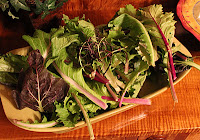Peasant woman planting beets, Vincent Van Gogh, 1885
|
During the winter in New England there's an abundance of hardy root vegetables at the market, especially farmers' markets. Snatch them up and incorporate them into your meals. My family doesn't love roots, but they enjoyed these meals. I just told them later what they ate! When buying roots, I can feed my family a nutritious meal and help out the farmers as well.
Red Lentil, Beet, And Carrot Soup
This nourishing soup was made by sautéing carrots, red onion, and candy cane beet in a little olive oil, salt and pepper. The stock was made by simmering a ham bone and its meat from a previous meal (below) in vegetable broth that looked like a good amount to serve my family of four, about 6 cups. Seasonings were simply dried thyme, bay leaves, pepper, and a pinch of salt.
 |
| Candy Cane Beet |
When all the sautéed vegetables became tender and flavorful, this I knew from the change in aroma when they started smelling sweet and wonderful, I added them to the stock along with a bag of red lentils. The stock was brought up to a boil, stirred, then simmered on low in a covered pot until the lentils were soft.
Short Ribs In Rich Beet Gravy
Shorts ribs from a local farm were browned separately then added to a slow cooker one morning which cooked all day making our home smell wonderful. But we had to wait a day to eat them since the gravy was fatty and needed extra attention.
After adding no-salt crushed tomatoes, a 28 oz. can, I added about a 1/4 cup of balsamic vinegar, some chopped carrots, celery, red onion, and a few red beets which resulted in a rich gravy after slow cooking on high for about six hours.
The meat was very fatty resulting in a fatty gravy. I removed the ribs and vegetables from the gravy and trimmed the fat from the ribs and placed them in separate glass storage containers.
Everything was refrigerated overnight so the fat would separate and could be skimmed from both the gravy and vegetables.
Once the fat was skimmed from the vegetables, they were pureed and added back to the skimmed gravy and reheated along with the trimmed rib meat while the mashed potatoes were made. The rich gravy and ribs were ladled over creamy mashed potatoes.
After making a few successful meals with hidden beets I tried to go straight. Even though my family knew in the end that beets were hidden in their meals and tasted delicious, no one bought it!
All the leftover red beets I had were simply roasted with red onions, dried thyme, and balsamic vinegar then served along side hardy greens from a local organic farm. And beets taste great roasted with balsamic vinegar!
The beets can be somewhat hidden by adding more vegetables or fruit, like slices of orange, pears, or apple, and by adding flavorful creamy goat cheese. But I didn't have any.
All I did for a dressing was drizzle a little more balsamic vinegar and extra virgin olive oil over the top. Without anyone to share, I enjoyed beet salad for lunch a few days that week. Everyone else made their own favorite salad combinations.
Meet My Yellow Beet Chili
For this chili I shredded yellow beets and carrots, vegetables that are not popular among my familial nibblers. I was anxious to hear what they thought and this was their favorite!
Once the vegetables were tender and ready, the aroma of their sweetness being a hint, local beef was added along with drained red kidney beans, low-sodium beef broth, and pasta sauce, which I choose instead of canned tomatoes because it's all I could find that was local and jarred (a safer alternative to canned), and chili powder. All was cooked until the flavors evolved and smelled deliciously ready.
Freshly grated local cheddar cheese as a garnish is always great.
A Ham Meal With Parsnips
It was a tradition at Christmas time to have a ham meal. We stopped when our daughter was diagnosed with a chronic kidney disease, FSGS, because she was placed on a low-sodium diet. Now that she's in clinical remission I thought we'd try it again after learning that one of our local farmers had some fresh smoked ham. We'll continue to watch our sodium intake, though.
All the vegetables roasted nicely with the ham and no one objected to the parsnips. The leftover ham and bone provided the base for the red lentil soup above.
If They Won't Eat Turnips, Feed Them Rutabagas
More mild than turnips, rutabagas fit in almost unnoticeably with the other vegetables I served as a side dish to this local chicken.
Breakfast Potato and Rutabaga Medley
Then for breakfast, leftover vegetables were served with local eggs. For the breakfast potato and rutabaga medley, I chopped up the vegetables, sprinkled them with a little paprika, and sautéed in a little olive oil until warm.
















































